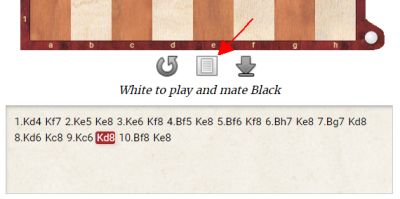


Here's an elementary mate you should be able to execute: two bishops against the sole king. Can you do it? Try mating Black in the following position.
The diagram will defend – but you can mate the black king if you know how. Remember, you only have fifty moves to do it.

You use the white notation button below the board to see the moves you have played, and can click on the notation to jump to earlier positions. The cursor keys of your keyboard allow you to move backwards and forwards.
If you don't succeed in trapping and mating the black king, let chess trainer Gauri show you how it is basically done. And then try to use the technique on the diagram above.
Next lesson: mating with bishop and knight. We have all seen this happen: you know you can do it, but have never had it in your games. Then one day it comes, in an important club game. And you fail to execute the mate in the fifty moves that the rules of chess allow.
You try it out against the diagram above, which will defend for Black. Convince yourself you know how to mate with bishop and knight.
And if you don't succeed, you can once again get brief instructions from Gauri.
Here the challenge is: can you win this position against the diagram? Move the white pieces and it will defend. Warning: it's a looong process, but quite easy to execute if you come up with a clear plan of how to do so.
The solution to the final puzzle will be posted here in a week.
The solution requires you to force the black king to the first rank – to b1, and then move the queen to h8 (or h6), sacrificing it on he, and then racing the white g-pawn to promotion, without the black king being able to stop it. Here is a possible way of doing it:
1. Qf6 Kd7 2. Qe5 Kd8 3. Qe6 Kc7 4. Qd5 Kc8 5. Qd6 Kb7 6. Qd7+ Ka6 7. Qc7 Kb5 8. Qd6 Ka5 9. Qc6 Kb4 10. Qd5 Kc3 11. Qe4 Kb2 12. Qd3 (12. Qc4 Ka3 13. Qb5 Ka2 14. Qb4 Ka1 15. Qd2 Kb1 16. Qh6 Kc2 17. Qxh3 gxh3 18. g4 Kd3 19. g5 Ke4 20. g6 $18) 12... Ka2 13. Qc3 Kb1 14. Qh8 Ka2 15. Qxh3 gxh3 16. g4 Kb3 17. g5 Kc4 18. g6 Kd5 19. g7 Ke6 20. g8=Q+ 1-0.
Try this against the above diagram and win the position against its defence.